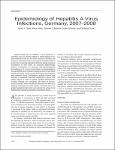Epidemiology of Hepatitis A Virus Infections, 2007-2008
Faber, Mirko
Stark, Klaus
Behnke, Susanne
Schreier, Eckart
Frank, Christina
Approximately 60% of hepatitis A virus infections in Germany occur in persons without a travel history to disease-endemic areas and for whom sources of infection are unknown. Recommendation of pretravel vaccination fails to prevent the remaining imported infections. Using enhanced surveillance in 2007–2008, we analyzed epidemiologic patterns of hepatitis A in Germany and appropriateness and adequacy of current immunization recommendations. Young patients with a migration background who had visited friends and family in their ancestral countries accounted for most imported cases. Phylogenetic analysis showed high diversity of sequence data and clustering of strains with similar regions of origin or patient migration backgrounds. Virologic findings are compatible with those of low-incidence countries, where virtually all infections are directly or indirectly imported from other regions. Germans with a migration background are seen as a special risk group so far insufficiently reached by pretravel vaccination advice.
Dateien zu dieser Publikation
Keine Lizenzangabe
Verwandte Publikationen
Anzeige der Publikationen mit ähnlichem Titel, Autor, Urheber und Thema.
-
2022-01-14ZeitschriftenartikelEpidemiologie der Virushepatitiden A bis E in Deutschland Dudareva, Sandra; Faber, Mirko; Zimmermann, Ruth; Bock, C.-Thomas; Offergeld, Ruth; Steffen, Gyde; Enkelmann, JuliaMit Virushepatitis A bis E werden verschiedene infektiöse Entzündungen des Leberparenchyms bezeichnet, die durch die Hepatitisviren A bis E (HAV, HBV, HCV, HDV und HEV) ausgelöst werden. Zwar ähneln sich die Krankheitsbilder, ...
-
2022-01-14ZeitschriftenartikelEpidemiologie der Virushepatitiden A bis E in Deutschland Dudareva, Sandra; Faber, Mirko; Zimmermann, Ruth; Bock, Claus-Thomas; Offergeld, Ruth; Steffen, Gyde; Enkelmann, JuliaMit Virushepatitis A bis E werden verschiedene infektiöse Entzündungen des Leberparenchyms bezeichnet, die durch die Hepatitisviren A bis E (HAV, HBV, HCV, HDV und HEV) ausgelöst werden. Zwar ähneln sich die Krankheitsbilder, ...
-
2015-07-06ZeitschriftenartikelOccult Hepatitis B Virus Infection in Nigerian Blood Donors and Hepatitis B Virus Transmission Risks Oluyinka, Opaleye O.; Tong, Hoang Van; Tien, Sy Bui; Fagbami, Ademola H.; Adekanle, Olusegun; Ojurongbe, Olusola; Bock, Thomas; Kremsner, Peter G.; Velavan, Thirumalaisamy P.Background: Occult hepatitis B virus infection (OBI) characterized by the absence of detectable HBsAg remains a potential threat in blood safety. We investigated the actual prevalence, viral factors and genotype of OBI ...

